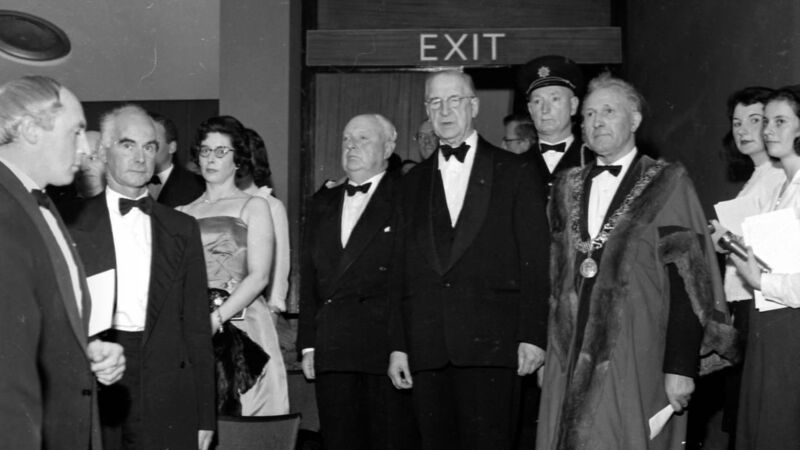10 things to know about Dev... including his commute to Cork

She died at the start of 1975 and Éamon passed away just months later at the age of 92. The end of an era.
For half a year, I’ve been immersed in his story while producing RTÉ’s to mark the 50th anniversary of his death.
The second episode of the series airs tomorrow evening, exploring the high and low points of his rule.
Here are ten surprising things I learned while making the series.
As a toddler, Dev was sent to his mother’s homeplace of Bruree on the Limerick/Cork border to be reared by his grandmother. He was bright and attended the Christian Brother School in Charleville nine kilometres away.
As a boy, Dev commuted from Bruree to school in Charleville every morning. Money was tight so he took the train one way and walked home. The Great Southern and Western Railway enabled a commuter life from the depths of the countryside to the nearest towns and cities!
Sadly, Bruree station closed to passenger traffic in 1934. Who knows what course Irish history might have taken if Dev had not been able to take the train!
de Valera was a fan of maths. He famously scratched a quaternion equation into his cell walls of Kilmainham jail.
He was interested in the subject throughout his life, and even in his later years in the Áras he used to ask staff to give him a maths problem to ponder on his daily walk.
He very nearly became a professor of mathematics in UCC in 1913. Ireland would surely be a different place if he had won the post and built a life in academia instead of politics.
de Valera’s most lasting contribution to science was his establishment in 1940 of the Dublin Institute for Advanced Studies.
Everyone knows that de Valera fought in the 1916 Easter Rising, and it is widely accepted that Boland’s Mills on Barrow Street in Dublin was where his battalion was positioned to take on British troops.
In fact, he was stationed nearby in Boland’s Bakery, not Boland’s Mills.
Despite widespread belief, it wasn’t Dev’s U.S birth cert that saved him from death for his involvement in the 1916 Rising.
Fifteen men were executed by firing squad over a nine-day period in May, 1916 (Roger Casement was killed later in the year). Public outrage against the executions and growing sympathy for prisoners were what halted the executions.
The British downplayed Dev’s role in the Rising and his death sentence was commuted to life imprisonment.
Dev is often blamed for the Civil War because he rejected the Treaty and inflamed opinion.
But he had no role in Collins’ fatal ambush at Béal na Bláth and wasn’t in charge of the military tactics of the Anti-Treaty forces during the Civil War.
de Valera was in Beál na Bláth on the morning of Collins’ death to see if an end to the fighting could be brought about, but he was given short shrift by the West Cork fighters. He went on his way but unfortunately Collins never made it back from Beál na Bláth.
de Valera and his wife had seven children between 1910 and 1933. His first born, Vivion, was named after Dev’s father. His third born he called Éamon. His third son, Brian, was killed, aged 20, in a riding accident in Phoenix Park in 1936.
After the loss and trauma of the revolutionary years, it must have been a terrible blow to the family to lose a son in such senseless circumstances.
Today, a prison record would sink most bids for public office (you’d hope!). Yet Éamon de Valera’s three stints behind bars - after the Rising, in the run up to the 1918 election, and during the Civil War - only boosted his revolutionary standing.
Dev turned captivity into political capital, riding Sinn Féin’s 1918 election landslide into a new chapter of Irish politics.
Though later celebrated as Gaeilge’s great defender, Éamon de Valera was not always fluent in the language.
Known in his youth as Eddie Coll and Eddie de Valera, he only embraced Irish identity after joining the Gaelic League in his mid-twenties, where immersion shaped both his politics and his lifelong cultural mission.
A generation of Irish men escaped the carnage of World War II thanks to Ireland’s neutral stance, ably navigated by de Valera. Yet neutrality also brought controversy.
In 1945, Éamon de Valera shocked many by offering condolences after Hitler’s death. He was sticking to rigid principles of neutrality but it was a grave misjudgement.
One of his most lasting political legacies, the 1937 Constitution, was drafted by de Valera and civil servant John Hearne with a skilled team over three years. It could have been far more Catholic, but Dev resisted Vatican pressure.
Despite outdated parts, Bunreacht na hÉireann remains a living, serviceable rulebook for Irish democracy. And, as a consequence, we are all still living in de Valera’s Ireland!
Watch on RTÉ1 and RTÉ Player on Wednesday, September 10 at 9.30pm.







 App?
App?




